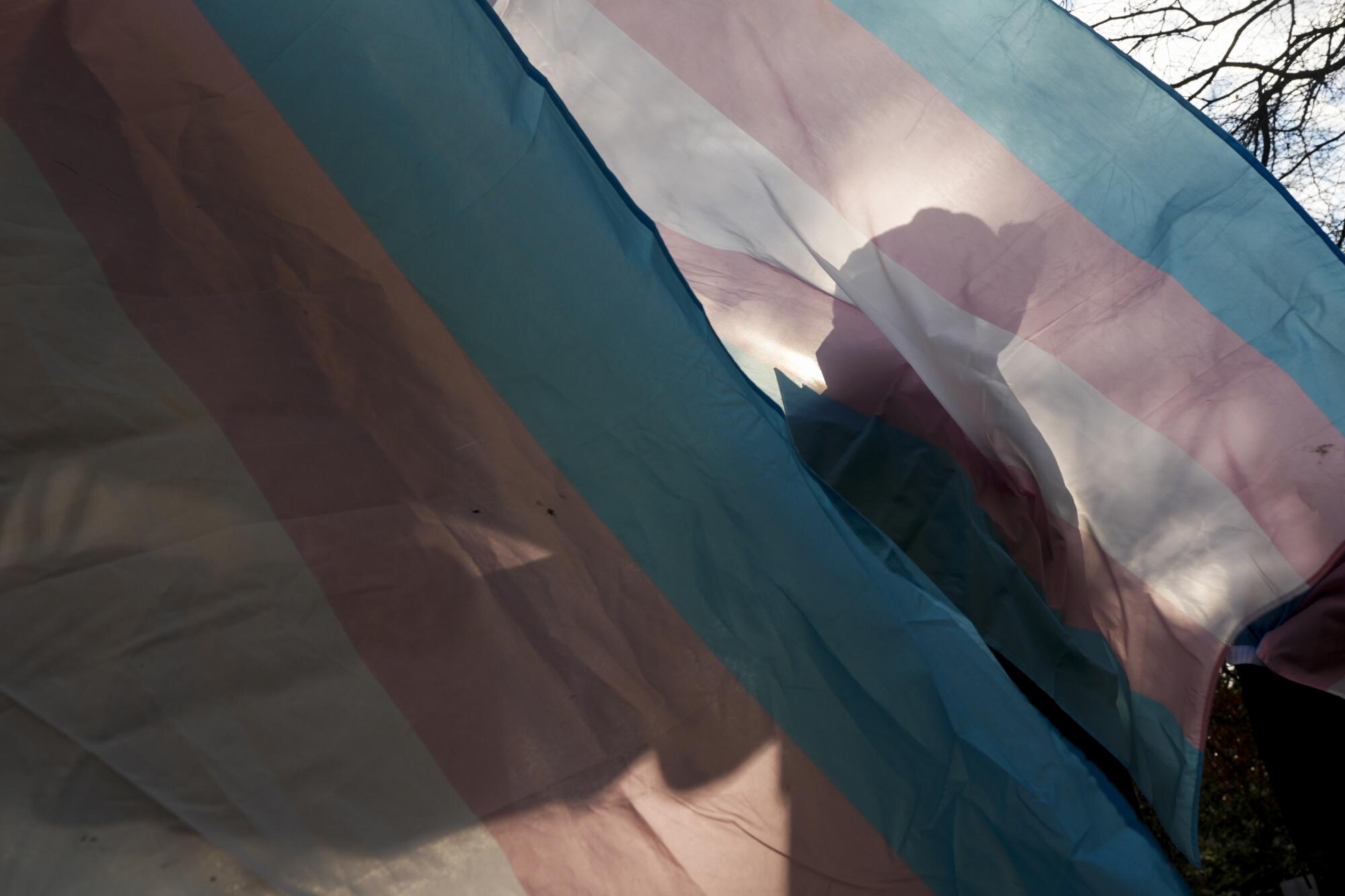
- Share via
There’s a scene toward the end of “Will and Harper” that I can’t get out of my head. I’m referring to the 2024 road-trip documentary where Will Ferrell is reintroduced to his old “Saturday Night Live” buddy Harper Steele as a trans woman. The two zigzag through several red states, as Ferrell, star of “Anchor Man,” “Talladega Nights” and “Elf,” is his quirky self, posing awkward questions (“How are your boobs?”), donning cartoonish disguises and pulling a series of public stunts, some of which backfire.
The goofiness comes to a halt when Harper drives them to Trona, Calif., a tiny town in the Mojave Desert, southwest of Death Valley. She pulls up to a dilapidated house with boarded-up windows on a small dirt plot — sad to even look at. She bought the place six or seven years before, wanting to get away from the world after another holiday season of uncertainty, regret and suicidal thoughts. “I just hated myself so much,” she says, and breaks down crying. “ I just felt like a monster.”
To defer to state legislatures on gender affirming care is to abandon a distinct group of people who are obviously discriminated against.
She brings him inside. The house has been vandalized; there’s broken furniture, walls full of graffiti, a bare mattress stained and smeared with who knows what. They step out on a small balcony overlooking an empty street with telegraph poles, the desert horizon in the distance. “I was going to be a woman here,” Harper tells Will. “That was the plan. … I was just gonna close the curtains and walk around this house and it was a safe space.”
That’s pretty desolate: an Emmy-winning comedy writer and producer, willing to forfeit everything, just to be a woman residing alone in the middle of nowhere. But the most desolate thing in the scene is Will Ferrell’s face, stricken with pathos. He has shifted from curiosity to certainty. Trans identity is real. He gets it.
Transgender and cisgender people are the same in this way: We’d sooner die than live outside of our gender. The difference is that cis people don’t have to face that predicament, while every trans person has.
The Trump administration threatened to punish the hospital if it continued to serve these patients. That’s no way to decide what medical services patients will receive.
Earlier this century, mainstream America started to catch on to the same thing about gay people: They’re real. They were born this way. Homosexuality isn’t a disease that straight people were going to catch. It took decades of LGBT organizing and fighting and (way too much) dying to get to that place. It also required a majority of straight Americans to perceive that gay identities are as real as theirs, to pave the way for marriage equality.
Transgender children are equally real, though conservative politicians and Christian nationalist groups have campaigned furiously to convince us otherwise. To be sure, many children go through phases of experimenting with gender expression. The way parents know one of their children is trans is by observing if their urge to transition is consistent, insistent and persistent. Consistent means you watch, insistent means you listen and persistent means you stay patient. These three things will make it quite obvious.
There’s one other thing. All parents of trans children experience a moment similar to Ferrell’s in the desert: They witness a person whose life is on the line, a person they must protect.
Red state lawmakers, who know nothing about medicine, want us to think “do no harm” means stripping trans kids of medical care, lest they make “permanent” decisions before they’re adults. Parents of trans children, and every major American medical organization, know that “do no harm” means preventing the catastrophe of undergoing puberty in the wrong gender. They also want to prevent suicide, and the nightmare of being forced to live in exile from your identity, which is a living death. Even Ron Burgundy, the Anchor Man, knows that.
As a trans person, I have avoided writing about sports because it only distracts from infinitely larger issues, such as access to healthcare, bodily autonomy and equal protection.
The Supreme Court Skrmetti decision handed down June 18, upholding a Tennessee law banning healthcare for trans minors, was as contorted as it was predictable. The justices had one thing to decide: Did a law explicitly targeting trans people deserve the heightened scrutiny applied to laws discriminating against protected groups or on the basis of sex?
Chief Justice John G. Roberts Jr., writing for the conservative majority, argued that the Tennessee law doesn’t “exclude any individual from medical treatments on the basis of transgender status but rather removes … gender dysphoria, gender identity disorder, and gender incongruence from the range of treatable conditions.” This is like saying we’re not targeting diabetics, just removing their insulin. Cisgender kids in Tennessee, however, can still receive hormones and puberty blockers because “the state has an interest in encouraging minors to appreciate their sex.” Justice Amy Coney Barrett, for good measure, claimed that transgender people don’t qualify as a protected group because a) we’re too hard to “define,” and b) we don’t suffer from a history of legal discrimination.
The Skrmetti decision will go down as discriminatory, deadly and patently false in its claims. After the Trump administration declared trans people nonexistent (then went about trying to eradicate what doesn’t exist), the court now sets a precedent and a permission structure for states to do whatever they want to us.
In her dissent, Justice Sonia Sotomayor effortlessly defined transgender people as a group, then pointed to “a lengthy history of … cross-dressing bans, police brutality, and anti-sodomy laws” that have criminalized trans people dating back to 1843. “Those searching for more evidence of de jure discrimination against transgender individuals,” she added, “need look no further than the present. The Federal Government, for example, has started expelling transgender servicemembers from the military and threatening to withdraw funding from schools and nonprofits that espouse support for transgender individuals.”
Diana Goetsch spent months visiting red-state libraries to do presentations on the freedom to read. Would she be recognized, or clocked as transgender?
Under New York state law I could have been arrested for cross-dressing in the 1980s, and instantly have lost my job as a public school teacher. A generation earlier, in San Francisco’s Tenderloin district, police often walked into Gene Compton’s cafeteria, a gathering place for neighborhood trans women, and randomly arrested customers for “female impersonation.” Amanda St. Jaymes was one of them. She described repeated arrests, being stripped and locked up for refusing to let them shave her head. “One girl [spent] 60 days in the hole because she wouldn’t let them cut her hair. That’s how important it was to us back then.”
In “Screaming Queens: The Riot at Compton’s Cafeteria” (another movie worth watching), historian Susan Stryker chronicles, through firsthand accounts, “the first known instance of collective militant queer resistance to police harassment in United States history.” It started with a police raid on a hot August night in 1966 (three years before Stonewall). When one of the cops grabbed one of the queens, she flung coffee in his face, and a riot erupted. Tables were turned over, people threw everything in sight, plate glass windows were smashed. They kicked and punched and beat the police with their heavy purses. “The cops retreated outside to call for backup. But cafeteria customers, maybe sixty in all, poured into the streets through the broken doors and windows and kept fighting” — in fearless feminine wrath.
“There was a lot of joy after it happened,” said St. Jaymes. “A lot of [us] went to jail, but there was a lot of ‘I really don’t give a damn. This is what needs to happen.’” The Compton’s riot demonstrates that transgender identity was as real 60 years ago — before we even had the word “transgender” — as it is now.
“I just ask you as my friends to stand up for me,” Harper Steele wrote in her coming out letter. I make that same appeal here, and I thank everyone who is standing up for trans people, as well as those who one day will. We’re real. We need you.
Diana Goetsch is a poet, essayist and journalist and the author of the memoir, “This Body I Wore.”
More to Read
Insights
L.A. Times Insights delivers AI-generated analysis on Voices content to offer all points of view. Insights does not appear on any news articles.
Viewpoint
Perspectives
The following AI-generated content is powered by Perplexity. The Los Angeles Times editorial staff does not create or edit the content.
Ideas expressed in the piece
- The author emphasizes that transgender identity is a profound reality, as illustrated by personal narratives like Harper Steele’s in the documentary “Will and Harper,” where isolation and self-loathing stem from societal rejection, highlighting the universal human need to live authentically in one’s gender.
- Medical care for transgender minors is framed as life-saving, with parents and medical experts viewing gender-affirming interventions as essential to prevent the “catastrophe” of forced puberty in the wrong gender and to reduce suicide risk, directly countering conservative claims that such care causes irreversible harm.
- Legal and political attacks—such as the Supreme Court’s Skrmetti decision upholding bans on youth healthcare and Trump-era policies erasing trans existence—are condemned as discriminatory and genocidal, rooted in historical oppression like cross-dressing arrests and police brutality dating to the 19th century.
- Historical resistance, exemplified by the 1966 Compton’s Cafeteria riot, underscores transgender resilience and the timeless reality of trans identity, challenging modern erasure narratives and framing allyship as a moral imperative to combat state-sanctioned violence.
Different views on the topic
- Critics argue that biological sex must dictate sports participation, asserting that transgender women’s inclusion compromises fairness in women’s athletics and that “overwhelming” global support exists for limiting female competitions to biological females, viewing this as an ontological imperative.[1]
- Gender-affirming care bans are defended as necessary to protect minors from “permanent” medical decisions, with proponents dismissing evidence from medical associations and framing state-level restrictions as safeguarding children from “experimental” treatments despite broad medical consensus.[2]
- Transgender identities are dismissed as ideologically driven “confusion,” with conservative figures claiming policies promoting transition “at any age” must cease to uphold “natural” gender appreciation, directly opposing the medical and lived realities affirmed by transgender individuals.[1][2]
A cure for the common opinion
Get thought-provoking perspectives with our weekly newsletter.
You may occasionally receive promotional content from the Los Angeles Times.













